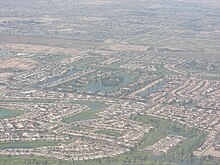

Urban sprawl (also known as suburban sprawl or urban encroachment[1]) is defined as "the spreading of urban developments (such as houses, dense multi–family apartments, office buildings and shopping centers) on undeveloped land near a more or less densely populated city".[2][3][4][5] Urban sprawl has been described as the unrestricted growth in many urban areas of housing, commercial development, and roads over large expanses of land, with little concern for very dense urban planning. Sometimes the urban areas described as the most "sprawling" are the most densely populated.[6][7] In addition to describing a special form of urbanization, the term also relates to the social and environmental consequences associated with this development.[8] In modern times some suburban areas described as "sprawl" have less detached housing and higher density than the nearby core city.[9][10][11] Medieval suburbs suffered from the loss of protection of city walls, before the advent of industrial warfare. Modern disadvantages and costs include increased travel time, transport costs, pollution, and destruction of the countryside.[12] The revenue for building and maintaining urban infrastructure in these areas are gained mostly through property and sales taxes. Most jobs in the US are now located in suburbs generating much of the revenue, although a lack of growth will require higher tax rates.[13][14][15]
In Europe, the term peri-urbanisation is often used to denote similar dynamics and phenomena, but the term urban sprawl is currently being used by the European Environment Agency. There is widespread disagreement about what constitutes sprawl and how to quantify it. For example, some commentators measure sprawl by residential density, using the average number of residential units per acre in a given area. Others associate it with decentralization (spread of population without a well-defined centre), discontinuity (leapfrogging development, as defined below), segregation of uses, and so forth.
The term urban sprawl is highly politicized and almost always has negative connotations. It is criticized for causing environmental degradation, intensifying segregation, and undermining the vitality of existing urban areas, and is attacked on aesthetic grounds. The pejorative meaning of the term means that few openly support urban sprawl as such. The term has become a rallying cry for managing urban growth.[16]
- ^ "What Is Urban Encroachment?". Sciencing. Retrieved January 15, 2021.
- ^ "The suburbs have become multifamily's new land of opportunity". Real assets advisor. Retrieved December 19, 2023.
- ^ "Phoenix area office market report" (PDF). Cushman and Wakefield. Retrieved December 19, 2023.
- ^ "Population of the Phoenix Area, Arizona". statistical atlas. Retrieved December 19, 2023.
- ^ "Definition of urban sprawl". Merriam-Webster. Retrieved January 25, 2022.
- ^ "What Density Doesn't Tell Us About Sprawl". Access magazine. Retrieved December 19, 2023.
- ^ Fouberg, Erin Hogan (2012). Human geography: people, place, and culture. Murphy, Alexander B.; De Blij, Harm J. (10th ed.). Hoboken: Wiley. p. 560. ISBN 978-1118018699. OCLC 752286985.
- ^ Sarkodie, Samuel Asumadu; Owusu, Phebe Asantewaa; Leirvik, Thomas (March 5, 2020). "Global effect of urban sprawl, industrialization, trade and economic development on carbon dioxide emissions". Environmental Research Letters. 15 (3): 034049. Bibcode:2020ERL....15c4049S. doi:10.1088/1748-9326/ab7640. ISSN 1748-9326.
- ^ "Population of the Kansas City area". Statistical atlas. Retrieved December 19, 2023.
- ^ "American housing survey housing characteristics". US Census. Retrieved December 19, 2023.
- ^ McCammon, Sarah (September 4, 2017). "As Kansas City Booms And Sprawls, Trying Not To Forget Those In Between". National Public Radio. Retrieved December 19, 2023.
- ^ Caves, R. W. (2004). Encyclopedia of the City. Routledge. pp. 626. ISBN 9780415252256.
- ^ "The land use and transportation connection Plano Texas". City of Plano. Retrieved December 19, 2023.
- ^ "Suburbs continue to dominate jobs and job growth". Bew Geography. Retrieved December 20, 2023.
- ^ Charles L. Marohn Jr. (2019). Strong Towns: A Bottom-Up Revolution to Rebuild American Prosperity. Wiley. ISBN 978-1119564812 – via Google Books.
- ^ James, Paul; Holden, Meg; Lewin, Mary; Neilson, Lyndsay; Oakley, Christine; Truter, Art; Wilmoth, David (2013). "Managing Metropolises by Negotiating Mega-Urban Growth". In Harald Mieg; Klaus Töpfer (eds.). Institutional and Social Innovation for Sustainable Urban Development. Routledge.